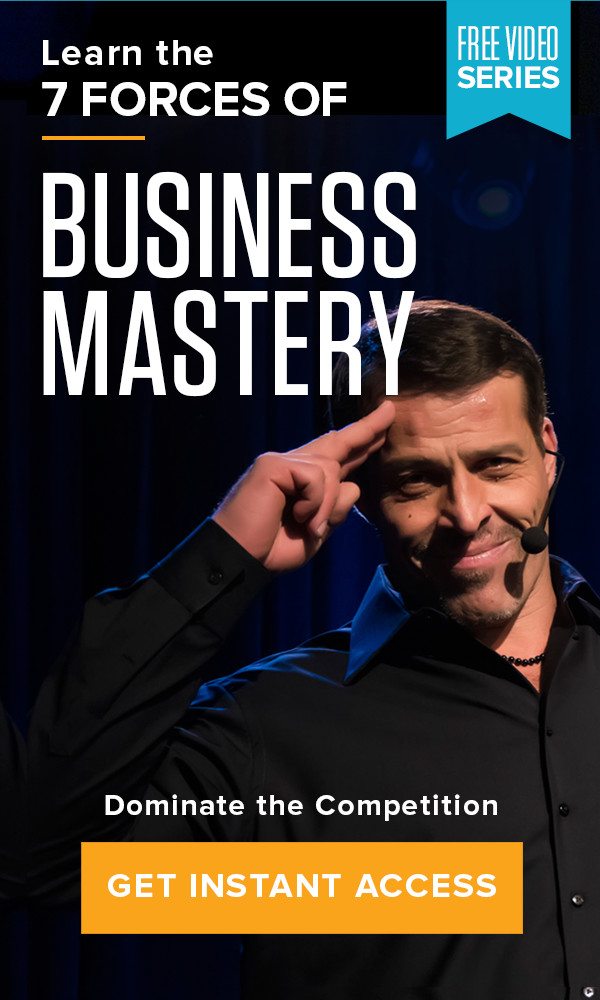Team Tony cultivates, curates and shares Tony Robbins’ stories and core principles, to help others achieve an extraordinary life.
Do you use video for marketing?
If not, you’re missing a big opportunity!
It’s clear that digital is the fastest-growing medium for marketing and advertising. Mobile has gone from the platform to watch to one that businesses must leverage to reach consumers.
Now it’s evident that video is the front-runner in the digital media race; it’s the fastest growing advertising category on mobile, on desktop and overall – outpacing even social media display spend.
Yet so many businesses still keep video on the back-burner. Is this you? Is video an afterthought, something you added in to your marketing plan at the last minute? If so, you’re missing a big opportunity.
Actually, you’re missing out on a massive opportunity. YouTube is the 2nd biggest search engine in the world, with over 1 billion users, and “every day people watch hundreds of millions of hours on YouTube and generate billions of views.” And Facebook’s video viewing audience is now 1.71 billion monthly active users.
Video is single-handedly transforming the way businesses reach and engage with their customers. So if you want to stay connected and relevant, then you better make video a key part of your marketing strategy.
But how do you get started? What outcomes should you strive for? And what are the pros and cons of creating video for TikTok, YouTube and Instagram? We sat down with YouTube sensation and video marketing expert Amy Schmittauer and talked about what it takes to create a powerful video that will not only engage your audience, but will help you build your brand and, ultimately, take your business to the next level.
What are businesses missing out on by not making use of video marketing?
Amy’s Answer
All businesses want to build a relationship with their customer and be able to scale that personalized experience, and video is a perfect opportunity to do that.
When you’re creating video content, you have both the visual and the audible components that allow you to have a much more personal effect that if you’re just tweeting or uploading images. It’s almost like sitting down with someone one-on-one. You can get on your customer’s radar, and give a personalized message of who you are, what your brand is all about and what value you bring to the table.
What if you don’t feel comfortable in front of the camera? Do you have to have an on-camera presence, or can you just feature your products or services?
Amy’s Answer
Here’s the thing. You can choose to not have a face on camera, and just focus on the product. But that’s also choosing the safe route, and anyone can do that. The reason that videos really make a difference comes from the human element — when it’s not like every other kind of video out there. And it’s also that human element that creates the connection with the audience. You are meeting someone at their level of understanding — before they know who you are, before they know what you sell. But how can you really create a connection with the audience by hiding from the camera?
There are a lot of times, particularly with smaller businesses, where there may just be a few people working for the company, and it feels like it’s falling on the president or the owner to be the on-camera presence. But if you’re not comfortable with that, then find someone you know that would make a good advocate for your brand. This is an opportunity to take people who love to be in front of the camera and let them do the talking for you. That’s really what this is about – letting people know who you are, what you stand for and what you care about.
What kinds of resources do you need to produce a video? Is it possible to learn the requisite skills yourself and create content yourself for a reasonable cost?
Amy’s Answer
You have one of the best cameras on the market in your phone. Simply press a button and record a video. So startup costs can be as little as that. There are also editing resources that are either free or extremely cheap, and because there are plenty that are drag-and-drop based, it’s simple too.
It really comes down to time, context, energy and strategy. If you want to invest a little bit to get more, then great. But as far as the startup cost for video goes, that just isn’t a good excuse anymore. If you get to a point where you’re actually making videos regularly enough, then you can spend money on a point-and-shoot camera or some gear. But the important part is to get started! There’s no use in buying that gear and letting the dust collect on it.
What are some entry-level tools or resources that you’d recommend?
Amy’s Answer
YouTube has an editor on the backend, which a lot of people don’t know. So you have the opportunity to film content on your phone, upload it to YouTube and keep it in private mode, then drag those clips together to create an entire project. It’s that simple. And you don’t even need storage for that. I believe YouTube also has an app called Director, that walks you through filming a video, which is a great tool for beginners to learn how to create a well-structured video.
If you have an Apple, iMovie is great and it comes along with a Mac or maybe costs a couple hundred dollars. But it’s an incredibly simple editing tool to use. Windows Movie Maker is comparable for a PC.
Another great resource that I love to recommend is Adobe Rush and Adobe Spark. You can import video clips and images, then utilize their templates and guides to create a video. They do a great job of helping you integrate words on frames – not just captions, but actual text overlays onto moving pictures and videos.
What are some good guidelines to adhere to for producing quality content? Are there any rules or benchmarks people should strive to hit?
Amy’s Answer
Absolutely. I think the thing that everyone needs to think about with content is who exactly are you talking to. You need to know your audience:
- what kinds of questions they have
- what they are Googling
- what they are thinking about
If you are a real estate agent, for example, your customer might not be ready to buy a house just yet, but perhaps they are millennials renting and looking for design advice or some great DIY tips around the house. That’s something they could look at now and could get them familiar with you and your brand. Then, when they are ready to take that next step, you will be the one that comes to mind.
Most people don’t think that way. They want to go straight to their product or service, thinking what they are doing is valuable content when really it’s just too narrowly focused. Even if you provide content like “how to price a home correctly” — it may be useful, but your audience will most likely already be thinking about buying or selling a home, and will then already have a realtor. So you really have to think “top of the funnel” when creating your videos. Remember, content is all about showing up for your customer in terms of what they’re thinking about right now, not what you think they need to know about your product or service.
Do the features of the video need to be different depending on what platform you’re going through?
Amy’s Answer
I personally think so. With YouTube, you really need to have a great thumbnail and a catchy headline to get someone’s attention. You can also be more of a talking head on YouTube because once someone clicks play, it’s all about your video. But that isn’t the same for Facebook. When a video starts playing automatically on Facebook when someone scrolls through a feed, it’s not about the title or thumbnail, it’s about the content, and it has to hook them. The viewer has to want to turn on the audio. So ask yourself, “what do I have to do to pull them out of the newsfeed and into watching my video?”
Captions can also make a big difference on Facebook videos, because if the viewer can’t hear you talking, they can at least see what you’re talking about and then opt to turn the audio on. Facebook captions are getting better and people are really making a point to carefully select their copy and even their font so it’s compelling.
Then with Snapchat, TikTok, and Instagram it’s a completely different ballgame. You’re dealing with disappearing content that’s in no way going to do well if it’s over-produced. People want a more behind-the-scenes look through these mediums.
How often should business owners strive to create new video content? Weekly, bi-weekly?
Amy’s Answer
It really has to do with context. With YouTube, you can build an archive – videos that will work for you for years. But with Instagram, your videos die in a couple days unless it becomes some viral sensation. Either way, once a week is industry standard. And that works across the board.
At the end of the day, you have to ask yourself how often you want to show up on the radar of your potential customer. If you are focusing on Facebook, and think that the video is probably not going beyond a couple days, then you shouldn’t have too much of a problem creating videos. Even something as simple as a twenty-second clip or a Boomerang shot is enough to keep the energy going. But with YouTube, perhaps you are going to put a little more time and thought into the production value. Then, you can just take a few moments of that longer video and repurpose those for Facebook.
On Instagram and Snapchat, you better not let your story die in 24 hours. Otherwise you don’t show up anymore. That’s the bar you have to strive for – to always be relevant. So it’s just a completely different model, which is why the frequency is so different than a platform like YouTube.
Header Image © Shutterstock / Africa Studio




